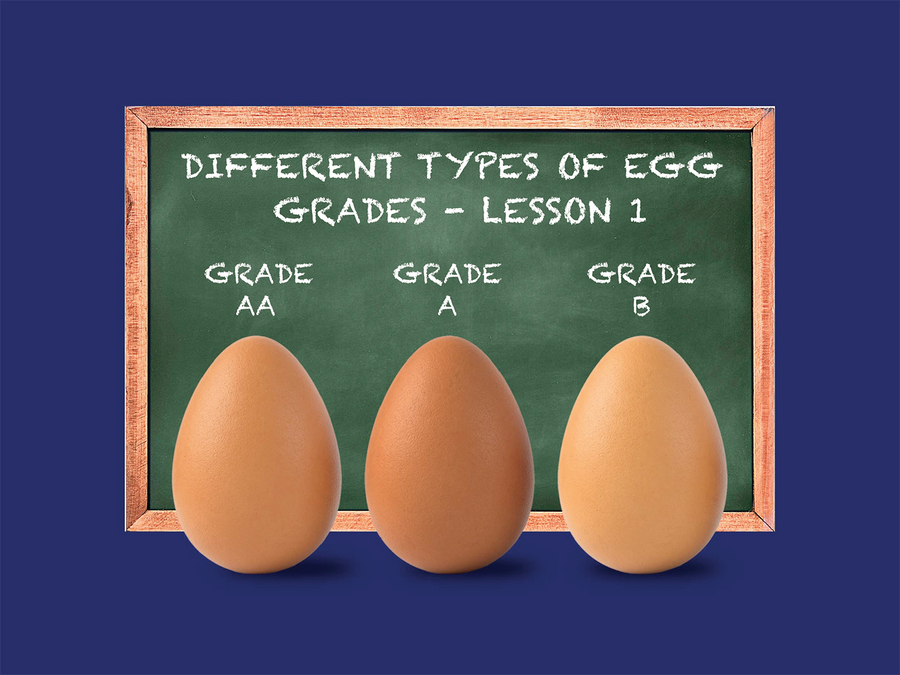
Take a moment to inspect any egg carton on the shelf at your local grocery store and you'll quickly notice that there's a lot more information printed on that familiar rectangular box than you might have realized. Alongside claims about animal welfare (think "free range" or "cage-free") and certifications like Certified Humane and USDA Certified Organic, you'll likely see the words "Grade A" printed somewhere. Read on to learn what egg grades mean, how egg grades are determined, and everything else you want to know Grade AA, Grade A, and Grade B eggs.
What are egg grades?
Egg grades are the categories that the USDA uses to indicate egg quality. You might have noticed that they're printed on every carton in the egg aisle. There are three grades:
- Grade AA
- Grade A
- Grade B
Because they're assigned according to features like round, robust yolks versus flat, watery ones, egg grades can be a helpful tool for consumers who are trying to make the best choice at the grocery store. Currently, the USDA only grades shelled eggs, so you won't see a grade on items like our organic liquid egg whites.
How are eggs graded?
There are a handful of quality indicators set by the USDA to qualify any given egg for one of the three grades listed above, but the most important indicators fall under three categories: shell quality, yolk quality, and egg white quality. The appearance and consistency of each of these three components of an egg ultimately determine its grade.
Shell quality
Grade AA and Grade A eggs have strong shells without cracks or breakage. The shells are clean and free of any residue such as feathers or dirt. Likewise, Grade B eggs don't have cracked or broken shells, but can have some minor visible stains.
Egg white quality
Grade AA and Grade A eggs have whites that are noticeably firm and substantial. When you crack a Grade AA egg into a frying pan, it will usually stay put for the most part - meaning the egg white won't spread much. You'll notice the same thing when frying a Grade A egg, but the white may spread a bit more. This is the most prominent difference between the two top grades. Grade B eggs, on the other hand, tend to have loose, watery whites that immediately spread when cracked into a pan.
Yolk quality
Both Grade AA and Grade A eggs have robust, strong yolks that generally don't break when the egg is cracked into a pan or bowl. If you were to crack one of these eggs onto a plate and view it from eye level, you'd see the yolk standing up above the white. Conversely, Grade B eggs have yolks that are more flat and stout than round with a tendency to break.
Does egg size affect egg grades?
Although the term "grading" is also used when referring to egg sizes and weights, the USDA's three quality grades do not take those factors into account. Egg weight classes are defined by the USDA, but as a whole different category separate from quality grades.
Do egg grades change over time?
Time can be a crucial factor when it comes to egg quality grades. Most fresh eggs from healthy hens start as Grade AA, but as the eggs age over the course of their journey from farm to grocery store, both the yolk and the whites naturally get looser and less firm, which lowers the grade.
Do egg companies have to grade their eggs?
You might be surprised to learn that the USDA's egg grading program isn't mandatory. But although their services are voluntary, the USDA still closely monitors the quality of all eggs sold in the United States via random inspections of facilities and cartons on store shelves. If you look closely, you'll see a grade on each carton of eggs in the grocery store, but only some of them will include the USDA's "shield" on their packaging. The shield indicates that the eggs have been graded by a trained USDA grader, whereas a grade without a shield means the eggs have been graded independently under the monitoring of state agencies.









